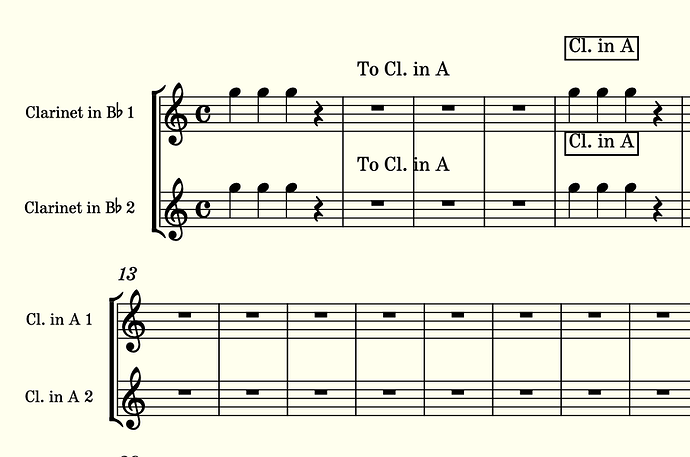My first music notation product was Sibelius, and for many years it was my only one - until I got a copy of Dorico a few years ago.
Right away, I could see how Dorico was the most sophisticated music editor on the market. Flows, condensing, frames - all game-changers. Best of all, I can use flows to add musical examples to footnotes, something very difficult in Sibelius - and possible only using static graphics. Switching in terms of the user interface was a mixed bag, although I do wish that Dorico had a numeric keypad like Sibelius does. My review here focuses on engraving, though, since the printed results are what matters.
Unfortunately, I noticed that there are some things that Dorico can not (easily) do - even some things that the other music editors do support - and so I do still use Sibelius from time to time. Although I am using an older version of Dorico, I will only include items that (to my knowledge) remain unavailable in the current version.
- Problems with instrument changes and transpositions - there are several of them, and the existing workarounds here are the hardest. When changing transpositions, the numbering changes also. For example, if I have Clarinet in B-flat I and Clarinet in B-flat II and I want them to both switch to A, I get Clarinet in A III and Clarinet in A IV. I do not want to number separately by transposition, because that will alter my numbering for other instruments. Much more importantly, I lose condensing when I do this. As helpful a feature as condensing is, its utility is compromised when I am limited to only one instrument - especially since B-flat to A for clarinet is a very common instrument change, even now. I can try to change instrument labels by hand, keeping separate players for each transposition as in the following item, but this sometimes results in inconsistent labels, especially when condensing. Another issue I’ve noticed is that the staff label for some horns will not include “alto” or “basso” as needed. For example, a horn in B-flat alto will appear as “Horn in B-flat I” and there is no way to get “alto” where I would like it to be. (Related to this: I cannot add a custom flat or sharp in the staff label.)
- Adjustable instrument ordering. This isn’t just about Flute III/Piccolo - well, it is, but even more complex. I’m notating a score with piccolo and three flutes, in which Fl. III doubles Picc. II. No matter which group goes on top in this scenario, a static order necessarily results in players of the same instrument being either non-consecutive or, worse, out of order. The existing workaround is to create separate Fl. III and Picc. II players and merge them in a new part layout. (Actually, a rather clever hack!)
- Rastral size presets and size reset for breaks. When setting a new space size during a system break or a frame break, I would love to have the same rastral size presets as seen in the Layout Options and Custom Staff Size. I love the rastral size presets in Dorico because the results are far more uniform that way. But this is important for the breaks as well; it is much more consistent to ask to downsize from size 3 to size 4, for instance, than to specify a 93% scale or even a 4.6 pt space size. Right now, I have to reference the Layout Options for the presets every time. Additionally, it would be nice to have an option to reset the space size to the layout default instead of again checking the Layout Options. Right now, I get size resets “for free” (automatic, in fact) only when I start a new flow.
- Beaming by syllable in vocal scores - both Sibelius and the (former) Finale support this. I’ve sung in an amateur choir where a piece new to our repertory used rhythmic beaming. Every one of us got a break in syllables wrong because the second syllable, which was intended for only the last eighth note of the measure, was beamed to other eighth notes belonging to the first syllable. (In fairness, a slur would have helped clarify the break; the score did not include this.) My point here is that plenty of singers continue to rely on flags for this purpose, and not the position of the text.
A few other features I’d like to see that aren’t quite as important for me are a tenor voice with a standard treble clef but still sounding an octave lower (i.e., with the octave assumed, as in many classic scores); a bass clarinet instrument that consistently uses bass clef even in transposing scores (I’ve edited the instruments XML file, and I know that we now have a proper instrument editor, but still, nice to see as a default feature); some additional standard instruments (basset clarinet, cannon - playback might be an issue); uniform indentation for systems using abbreviated staff labels (maybe just an option to use the maximal abbreviated length for all such systems - ‘quick and dirty’, but this does reduce the number of calculations); and proper playback of triplet tremolos (not exactly a question of engraving).
I’m sorry again for the length of this post. Most of these issues already have their own threads, so I just wanted to write a run-down of the ones that stick out most to me.
EDIT: Another issue that I noticed, which I believe is still present even in Dorico 5, is that condensed labels omit the last full stop - e.g., “Flute I.II” instead of “Flute I.II.” - which is inconsistent with the “I.II.” playing direction in Engraving Options, which I use. It would be nice to add the last full stop back for consistency, and maybe even add more options for condensed labels generally. This is also a lower-priority issue for me.
